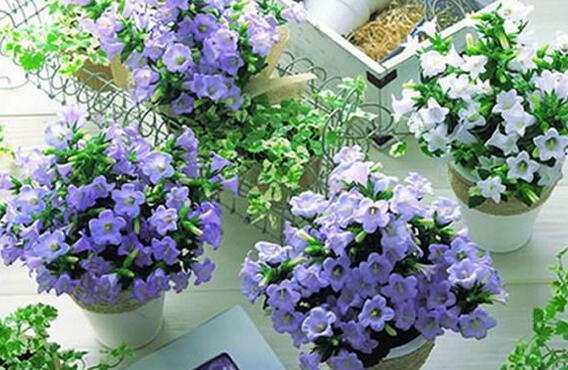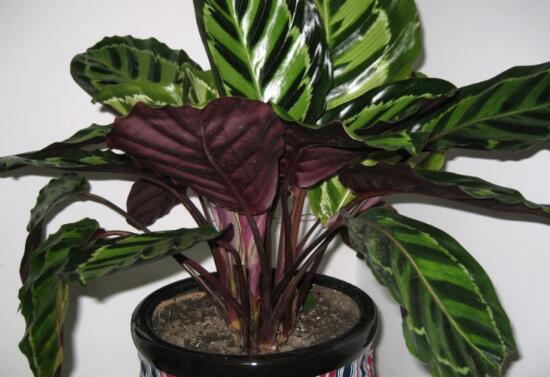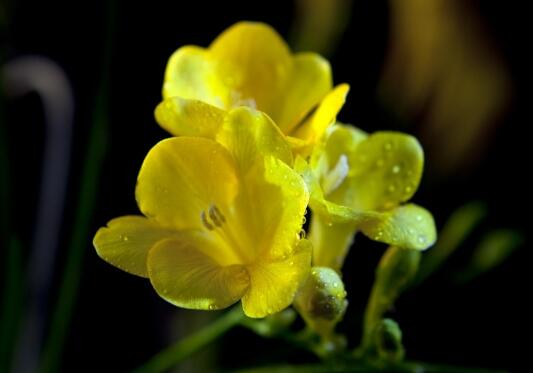How to raise potted bluebells, breeding methods and matters needing attention / temperature control
It is well known that the efficacy and function of bluebells are many. Its flowers are as graceful and pleasant as wind chimes. They can not only be watched but also beautified at home, but they need to know some of their breeding skills before breeding. and how to raise potted bluebells? Let's take a look at the breeding methods and matters needing attention of bluebells.
How to raise potted bluebells

Before planting, you should be familiar with the growth habits of bluebells. Its characteristic is that it is sensitive to temperature, the suitable temperature for growth is 13-18 degrees, the temperature in winter can not be lower than 2 degrees, and the leaves will turn yellow when the temperature is higher than 30 degrees in summer. In addition, it also likes a moist environment with plenty of light, and has lower requirements for fertilizer and soil.
Culture methods and matters needing attention of bluebells
I. Culture methods of bluebells
1. Soil and flowerpot
The planting of bluebells is mainly in shallow pots, and the best soil is sandy soil, preferably slightly acidic or slightly alkaline soil, with a PH value between 5.5 and 6.2. If the soil is too acidic, a small amount of lime can be added to neutralize it. Garden soil and livestock manure can be mixed to make culture soil.
2. Lighting
Campanula does not need light at the stage of germination, but it can slowly increase the light after germination, and it is necessary to ensure that the light is more than 14 hours a day during the peak growth period, so as to ensure that it blossoms ahead of time and the color of the flower is more gorgeous, but it is usually maintained as long as the light is enough to avoid being too dark.
3. Temperature
Temperature is a very important factor in the cultivation methods and precautions of bluebells, because bluebells are sensitive to temperature. The best temperature for its growth is 13-18 degrees, and the suitable temperature for germination is 20-22 degrees. It is necessary to keep the temperature below 2 degrees in winter and 28 degrees in summer.
4. Moisture
How to raise potted bluebells in watering? After emergence, you can keep the soil slightly moist and do not soak through. During the growing period, you should follow the principle of watering after the soil surface is white and dry, and watering thoroughly every time. Usually, you need to water flexibly according to climate change, such as frequent watering in summer and less watering in winter.
5. Fertilization
In the growth process of bluebell grass does not need frequent fertilization, its demand for fertilizer is relatively small, in the seedling growth stage, calcium and nitrogen fertilizer can be applied to promote growth, and then the growth period can be topdressing phosphorus and potassium fertilizer.
II. Matters needing attention in the cultivation of bluebells
1. Due to the higher temperature requirements of bluebells, lower than 2 degrees or higher than 30 degrees will lead to withered leaves and plant wilt, so we must pay attention to keeping warm and cooling in winter and summer. In addition, the temperature difference between morning and evening should not be too large.
2. Bluebells can adapt to the semi-shady environment, and it also likes places with plenty of light, but it must be kept in a shady place in summer, so that it can not be exposed to the sun, otherwise it is not conducive to cooling and burns the leaves.
3. In order to avoid the management of bluebells growing too high, it needs to be topped at the seedling stage, that is, when it grows to 7-8 cm, the buds at the top can be removed, which can control the height and let it sprout side branches, while increasing the number of flowers.
4. Pay attention to the prevention and control of diseases and insect pests, it is vulnerable to red spiders, aphids, powdery mildew, leaf spot disease, if the leaf yellowing, curling and other phenomena should be found as soon as possible, otherwise it is easy to affect its normal growth.
Culture methods and matters needing attention of Camellia oleifera how to raise Campanula
Flower bonsai network guide: today's flower bonsai network editor is to share for you the article about the breeding methods and matters needing attention of bluebells, how to raise bluebells, let's take a look.
Propagation methods of bluebells
Campanulaceae (scientific name: Campanula) is a flowering plant of Campanulaceae. Its flowers are like wind chimes, so it is named after wind chimes.
Bluebells, also known as bell flowers, is a perennial herb, so how does bluebells reproduce and what breeding methods are there? let me tell you!
There are about 300 species and several subspecies under the genus Campanula, which are distributed in the temperate zones of the Northern Hemisphere and have the highest diversity from the Mediterranean to the Caucasus. The species of the genus Campanula include annual, biennial and perennial plants, ranging in height from 5 cm in polar and mountainous regions to 2 m in temperate grasslands and woodlands. Sowing and propagation of bluebells
One of the most important propagation methods of bluebells is sowing and reproduction.
First of all, choose the time of sowing, sowing in spring or late winter and early spring, choose small seeds, first dry the seeds, then store them, and wait until spring to sow.
Second, in the spring, sprinkle the seeds evenly in the soil, pay attention to cover the soil, do not cover too thick. The soil should also be kept moist, but do not accumulate water; pay attention to shade and avoid direct sunlight.
Waiting for the seedlings to grow, they should be watered on time and according to the amount of water, and fertilizers should be applied, mainly compound fertilizers.
Finally, seedlings can be raised by split-plant or cutting method, and then planted; after planting, enough fixed root water should be irrigated, and the later growth can be managed according to general management.
If you choose to sow in autumn, the seedlings will not blossom until the next spring and summer.
Cultivation and management of sowing and propagation
After sowing, it is necessary to manage the cultivation:
First of all, transplant: about the 8th week after the plant sprouts, you can use a flowerpot with a mouth of about 11cm for transplantation and cultivation.
When cultivating, we should choose the soil with good drainage and clay in the substrate.
The second is the light, usually during the day, we should pay attention to give enough light. But at night, the supplementary light should be interrupted, which is beneficial to the growth of the plant.
Finally, fertilization management: when right and wrong, you need to apply fertilizer alternately every week, pay attention to the amount of fertilizer needed by the plant, and keep it medium.
Don't apply fertilizer in mid-September.
The leaves of the genus Campanula are alternate leaves, and the shape of the leaves on a single plant is different, from the broadest at the bottom to the narrower at the top. The edges of the leaves can be smooth or jagged. The leaves and stems of many species have white latex. The flower has a stalk, the Corolla has 5 petals, and the petals are large and blue to purple, sometimes white or pink. There are five leaf-like sepals under the Corolla to form the calyx. Some species have additional leaf-like appendages between each sepal, which can be used to distinguish closely related species. The fruit is a capsule containing a large number of small seeds.
The genus Campanula is generally used as food for Lepidoptera larvae, including Eupithecia vulgata, Spodoptera litura, Spodoptera litura, Spodoptera litura and mouse moths.
Famous species include Camellia oleifera from northern Europe and bluebells from southern Europe. In addition to wild Campanula in northern Europe, there are also many cultivated species. Camellia oleifera is a biennial plant widely cultivated in Europe. Brother Grimm's Rapunzel is named after this plant.
Culture methods and matters needing attention of bluebells
Campanula is a kind of common herbaceous flower in late spring and early summer with strong plant type, tenacious growth and bell-like shape. A lovely appearance is often used as a potted ornamental. The following editor will introduce the breeding methods and matters needing attention of bluebells!
Sowing method of bluebells sowing time
Campanula is a cool plant, it is best to sow at the end of summer, after growing slowly in winter, the whole growth process can be completed in spring. In this process, the lighting time should be at least 14 hours a day, blossom in about 30 days, and the viewing period will be longer.
Seedling maintenance
After sowing, when the seedlings grow small roots, you can transplant, choose a shallower flowerpot. Be careful not to break the root system during planting. If the seedling grows to about 5 centimeters, it can be transplanted into a flowerpot of about 10 centimeters, and after the root system grows full of pots, the pots will be changed for 2 or 3 times, and a full pot of bells can be harvested.
Watering and fertilization of Lingdang Flower Culture
The seedlings of Lingdang flowers should be watered frequently to ensure high humidity and, if necessary, be covered with vermiculite to moisturize the seedlings. However, when watering, do not sprinkle the seedlings, lest the water will break the stems of the seedlings.
If you want to promote the rapid growth of bluebells, you can appropriately increase the application of calcium and nitrogen fertilizer, and then topdressing phosphorus and potassium fertilizer on this basis.
Light and temperature curing
Bluebells like long sunshine and can blossom naturally when the light is more than 14 hours a day. If you want to blossom early, you only need to do dark treatment 30 days before flowering, 4 hours a day.
The bluebell grass does not need to control the plant type, it is already short, and the appearance of the early bluebell grass will be more messy, do not give pruning, let it grow slowly, the later stage will naturally be neat and compact.
Matters needing attention in culturing bluebells patience
Campanula takes two winters to blossom, so it takes patience to cultivate, especially in the hot summer weather, which can easily cause the plant to wither.
Sunscreen
Potted bluebells can not be placed on the back of high-rise buildings to prevent sun exposure, and timely strengthen the foliar spray and cooling. Bluebells are also positive plants, so they can't be kept in the shade for a long time and lack of light.
Culture methods and matters needing attention of bluebells
Sowing method of bluebells
Sowing time
Campanula is a cool plant, it is best to sow at the end of summer, after growing slowly in winter, the whole growth process can be completed in spring. In this process, the lighting time should be at least 14 hours a day, blossom in about 30 days, and the viewing period will be longer.
Seedling maintenance
After sowing, when the seedlings grow small roots, you can transplant, choose a shallower flowerpot. Be careful not to break the root system during planting. If the seedling grows to about 5 centimeters, it can be transplanted into a flowerpot of about 10 centimeters, and after the root system grows full of pots, the pots will be changed for 2 or 3 times, and a full pot of bells can be harvested.
Culture method of Lingdang Flower
Watering and fertilization
The seedlings of Lingdang flowers should be watered frequently to ensure high humidity and, if necessary, be covered with vermiculite to moisturize the seedlings. However, when watering, do not sprinkle the seedlings, lest the water will break the stems of the seedlings.
If you want to promote the rapid growth of bluebells, you can appropriately increase the application of calcium and nitrogen fertilizer, and then topdressing phosphorus and potassium fertilizer on this basis.
Light and temperature curing
Bluebells like long sunshine and can blossom naturally when the light is more than 14 hours a day. If you want to blossom early, you only need to do dark treatment 30 days before flowering, 4 hours a day.
The bluebell grass does not need to control the plant type, it is already short, and the appearance of the early bluebell grass will be more messy, do not give pruning, let it grow slowly, the later stage will naturally be neat and compact.
Matters needing attention in the culture of bluebells
patience
Campanula takes two winters to blossom, so it takes patience to cultivate, especially in the hot summer weather, which can easily cause the plant to wither.
Sunscreen
Potted bluebells can not be placed on the back of high-rise buildings to prevent sun exposure, and timely strengthen the foliar spray and cooling. Bluebells are also positive plants, so they can't be kept in the shade for a long time and lack of light.
- Prev

How to raise peacock arrowroot, peacock arrowroot cultivation methods and precautions/water to be sufficient
Peacock arrowroot, one of many arrowroot varieties, looks especially beautiful with its fresh leaf color. Whether at home or in public places, peacock arrowroot can play a very good role in beautification. How can peacock arrowroot be raised? The following small series carefully arranged peacock arrowroot breeding methods and precautions
- Next

How to raise fragrant snow orchid, how to cultivate fragrant snow orchid and matters needing attention / sufficient light
Xiangxue orchid is a kind of ornamental flower native to southern Africa, which was introduced to China and can be seen in many parts of our country. However, if you want to raise this kind of plant well, there are many things you need to pay attention to, so how to raise fragrant snow orchid? What are the culture methods and points for attention of Xiangxue orchid?
Related
- Fuxing push coffee new agricultural production and marketing class: lack of small-scale processing plants
- Jujube rice field leisure farm deep ploughing Yilan for five years to create a space for organic food and play
- Nongyu Farm-A trial of organic papaya for brave women with advanced technology
- Four points for attention in the prevention and control of diseases and insect pests of edible fungi
- How to add nutrient solution to Edible Fungi
- Is there any good way to control edible fungus mites?
- Open Inoculation Technology of Edible Fungi
- Is there any clever way to use fertilizer for edible fungus in winter?
- What agents are used to kill the pathogens of edible fungi in the mushroom shed?
- Rapid drying of Edible Fungi

